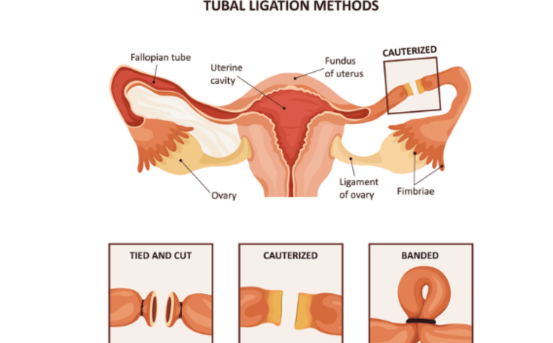Tubal ligation reversal surgery, often referred to as “getting your tubes tied,” is a permanent form of female sterilization. It involves surgically blocking, cutting, or sealing the fallopian tubes to prevent pregnancy. While it is highly effective and intended as a lifelong contraceptive solution, many women later experience regret and consider tubal ligation reversal.
For many women, the decision to undergo sterilization is deeply personal and influenced by a variety of factors including medical concerns, family planning goals, or pressures from a previous relationship. But it is not uncommon for women to later experience what is known as “sterilization regret.” This change of heart often leads them to consider tubal ligation reversal a surgical attempt to restore fertility by reconnecting the fallopian tubes.
What Is Tubal Ligation Reversal?
Tubal ligation reversal is a surgical procedure that reconnects or repairs the fallopian tubes that were blocked or cut during sterilization. The goal of the procedure is to restore fertility so that a woman can conceive naturally. This reversal is not always successful, and its effectiveness depends on several factors including age, the method of original sterilization, and overall reproductive health.
Why Do Women Choose Tubal Ligation Reversal?
While tubal ligation is considered permanent, many women later experience a change in life circumstances that prompts them to revisit their decision. Here are the most common causes for tubal ligation reversal:
Change in Marital Status or New Relationship
One of the most common reasons for considering tubal ligation reversal is a change in marital or relationship status. A woman may have had the procedure done with a former partner and now desires children with a new spouse. This emotional shift can be a powerful motivator, especially if the new partner does not have children or wishes to grow a biological family.
Regret After Sterilization
Some women experience sterilization regret, particularly if the decision was made under pressure or during stressful life events such as complicated pregnancies, financial instability, or relationship issues. In some cases, women report feeling that they weren’t fully informed about the permanence of the procedure or that they were too young to make such a life-altering decision.
Desire for More Children Due to Life Changes
A woman’s feelings about family and children can evolve over time. Even if she initially felt that her family was complete, changes such as improved financial conditions, personal growth, or the loss of a child can reignite the desire for more children.
Loss of a Child
The devastating loss of a child can lead to profound grief and may prompt parents to consider expanding their family again. For mothers who have undergone tubal ligation, reversal may be a path to healing by giving them a chance to conceive naturally once more.
Religious or Cultural Beliefs
In some cases, women seek tubal ligation reversal due to religious or cultural beliefs that oppose permanent sterilization. These women may feel a spiritual or moral obligation to restore their fertility and embrace natural conception methods.
Improved Medical or Financial Conditions
Some women undergo sterilization during times of medical uncertainty or economic hardship. Later in life, with better health or financial stability, they may feel more equipped to have additional children and pursue reversal surgery.
Psychological and Emotional Reasons
For many women, the inability to conceive again even if previously chosen can lead to feelings of loss, depression, or a sense of being incomplete. The emotional impact of tubal ligation can be profound, and reversing the procedure may offer emotional relief and restore a sense of femininity or wholeness.
Who Is a Good Candidate for Tubal Ligation Reversal?
Not all women are candidates for successful reversal. Doctors evaluate the following factors :-
-
Age :- Women under 40 typically have better outcomes.
-
Type of tubal ligation :- Some methods are more easily reversible than others.
-
Length of remaining fallopian tube :- The longer the remaining healthy tube, the higher the success rate.
-
Overall reproductive health :- Including egg quality, uterine condition, and partner’s sperm health.
A fertility specialist or gynecologic surgeon can provide a thorough assessment and recommend the best approach.
Alternatives to Tubal Ligation Reversal
For women who are not ideal candidates for reversal surgery, in vitro fertilization (IVF) may be a viable alternative. IVF bypasses the fallopian tubes entirely by fertilizing the egg in a lab and implanting it directly into the uterus.
IVF vs. Reversal :-
-
IVF has higher success rates in some cases, especially for older women or when the tubal damage is severe.
-
Tubal ligation reversal allows for the possibility of natural conception multiple times without repeated IVF cycles.
Choosing between the two depends on individual goals, health conditions, and personal preference.
What to Expect During Tubal Ligation Reversal Surgery
The procedure is usually done through laparoscopic or mini-laparotomy surgery. During the operation :-
-
Scarred or blocked portions of the tubes are removed.
-
Healthy ends of the tubes are rejoined using microsurgical techniques.
-
A dye test may be used to check for tubal patency (openness).
Most women can go home the same day and recover within 2–4 weeks. Full healing of the reproductive system may take a few months, and doctors usually advise waiting before attempting pregnancy.
Success Rates of Tubal Ligation Reversal
Success rates vary depending on several factors, but here are general estimates :-
-
Women under 35 :- 60–80% pregnancy rate after reversal
-
Women aged 35–40 :- 40–60% success rate
-
Women over 40 :- Lower success rate, typically 20–30%
Success also depends on how much healthy fallopian tube remains and whether there are other fertility issues.
Conclusion
Tubal ligation reversal is a deeply personal decision, often rooted in emotional, relational, or life-changing circumstances. Whether driven by regret, a new relationship, the loss of a child, or renewed hope for expanding a family, thousands of women explore this option every year.























